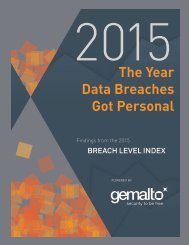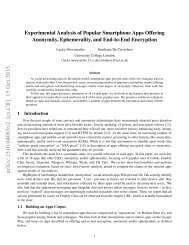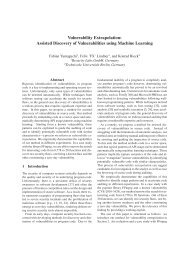Deobfuscating Embedded Malware using Probable-Plaintext Attacks
Deobfuscating Embedded Malware using Probable-Plaintext Attacks
Deobfuscating Embedded Malware using Probable-Plaintext Attacks
Create successful ePaper yourself
Turn your PDF publications into a flip-book with our unique Google optimized e-Paper software.
8 <strong>Deobfuscating</strong> <strong>Embedded</strong> <strong>Malware</strong> <strong>using</strong> <strong>Probable</strong>-<strong>Plaintext</strong> <strong>Attacks</strong><br />
the difference streams ∆P and ∆C. If the difference streams match at a specific<br />
position and the plaintext P is sufficiently large, we have successfully determined<br />
the occurrence of a plaintext in the obfuscated data. In particular, we compute<br />
the difference stream<br />
∆P = (P 1 ◦ −1 P 1+l ) . . . (P m−l ◦ −1 P m )<br />
for the plaintext P and compare it against each position i of the ciphertext C<br />
<strong>using</strong> the corresponding stream<br />
∆C = (C i ◦ −1 C i+l ) . . . (C i+m−l ◦ −1 C i+m ).<br />
Using this technique, we can efficiently search for probable plaintexts in data<br />
obfuscated <strong>using</strong> a Vigenère cipher without knowing the key. This enables us to<br />
check for common strings in the obfuscated code, such as header information,<br />
API functions and code stubs. Once the position of a probable plaintext is found<br />
it is possible to derive the used key by applying the appropriate inverse operation:<br />
K j = C i+j ◦ −1 P i+j with i being the position where the difference stream of a<br />
probable plaintext matches. The more plaintexts match in the obfuscated code,<br />
the more reliably the key can finally be determined.<br />
3 <strong>Deobfuscating</strong> <strong>Embedded</strong> <strong>Malware</strong><br />
After describing attacks against Vigenère ciphers, we now present our method<br />
Kandi that combines and extends these attacks for deobfuscating embedded<br />
malware. The three basic analysis steps of Kandi are described in the following<br />
sections and outlined in Figure 4. First, our method extracts probable plaintexts<br />
from a representative set of code (Section 3.1). Applied to an unknown document,<br />
it then attempts to estimate the key length (Section 3.2) and finally break any<br />
Vigenère-based obfuscation if present in the file (Section 3.3).<br />
Frequent substrings<br />
Code BC<br />
<strong>Plaintext</strong>s<br />
Code A BC<br />
A<br />
Code A BC<br />
BC<br />
Code A<br />
Gaps between<br />
recurring substrings<br />
DOC S S<br />
Key<br />
length<br />
<strong>Probable</strong> plaintexts<br />
A BC<br />
DOC Z XY<br />
Key<br />
(a) (b) (c)<br />
Fig. 4. Schematic depiction of Kandi and its analysis steps: (a) Extraction of plaintexts,<br />
(b) derivation of the key length and (c) probable-plaintext attack.<br />
In particular, we are <strong>using</strong> the Kasiski examination for determining the<br />
key length in step (b) and the technique of key elimination against XOR and<br />
ADD/SUB substitutions in step (c). Additionally, we are testing each possible<br />
transposition for ROL/ROR instructions. We consider this a legit compromise<br />
since there exists only a few combinations to check.









